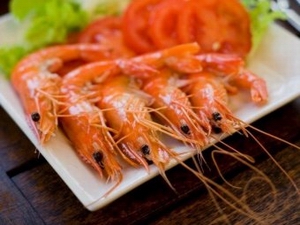 wn and barramundi farmers have moved one step closer to merging their industry bodies, but fell short of joining as one after talks in Cairns this week.
wn and barramundi farmers have moved one step closer to merging their industry bodies, but fell short of joining as one after talks in Cairns this week.Instead, an agreement was reached to form a national alliance, as the annual joint conference of the Australian Prawn and Barramundi Farmers Associations closed yesterday.
Outgoing president Alistair Dick says with new farms in the pipeline for the first time in a decade, there's renewed optimism the tide is finally turning for Australian aquaculture.
"I think the time is right," he said.
"With a falling Australian dollar, obviously imports become more expensive, and with some changes in regulation and a few other things like some issues in Asia with prawn diseases, it really provides the impetus for Australian aquaculture to kick on."
Mr Dick's sentiment reflects an air of confidence at this year's conference where the mood has been decidedly upbeat.
There's been groundbreaking research unveiled by the CSIRO paving the way for a new "perfect" prawn food as an alternative to using wild harvested fish products.
Renowned "shrimp doctor" Matt Briggs also highlighted concerns about Early Mortality Syndrome (EMS) outbreaks in South East Asia and Mexico and advantages for unaffected countries such as Australia in fiercely protecting its "clean, green" reputation.
And then, a Western Australia-based consortium, CO2 Australia, revealed its plans to develop the first new prawn farm in Australia in 13 years.
Mr Dick says it all points to a positive outlook for prawn and barra farmers, but government "green tape" remains an impediment.
"So all of the ingredients are there to see the industry grow," he said.
"We just need a bit more education and a bit more confidence that, when people put in an application, they can take it all the way and be operational."
Much of the regulatory approvals are a state responsibility, but the Coalition's fisheries spokesman Richard Colbeck says the Federal Government could and should do more to streamline the process.
Senator Colbeck outlined a national aquaculture strategy and plans for a "one stop shop" for new development approvals.
"Potentially, even the development of zones where aquaculture could have a faster track through environmental approval processes, having done all the base work already, so we know what the requirements are and industry understands upfront what they're going to have to go through as part of that process."
Senator Colbeck may have stopped short of giving a commitment on 'country of origin' labelling - one of the hot button issues at this year's conference - but there's definitely an air of optimism in the industry.
Wayne De Bertolo, from Pacific Reef Fisheries at Ayr, says the farm produced its biggest crop of 800 tonnes last year and is on track to break that record again.
Gold Coast Marine Aquaculture's Nick Moore says an easing of the currency exchange rate will help Australian farmed prawns, but the full benefits won't be felt until production ramps up later in the year.
"More importantly, as the dollar drops, imported product becomes dearer to bring in and our wild guys can export and make money as well, rather than flood the Australian market."
At last night's industry awards, Matt West, from Australian Prawn Farms, and David Symonds, from Campwin Beach Farm, both in Mackay, were recognised for their contribution to prawn farming.
Winner of the 'best sustainability' initiative was Courtney Remilton, of Seafarm (Cardwell), and 'best farm worker' was Justin Forrester, of GFB Fisheries in Bowen.







